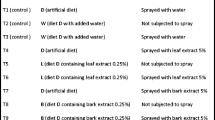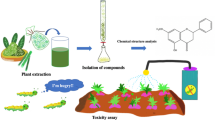Abstract
Spodoptera frugiperda (fall armyworm; FAW) is a generalist herbivore that has a severe impact on crop production. Due to its wide range of host plants, FAW fitness on weeds was evaluated. Field dodder (Cuscuta campestris Yunck.) is an obligate parasitic plant that severely impacts crop production, and the disposal of C. campestris residue needs to be handled carefully. Therefore, finding an alternative application may be the best method for disposal. In this study, extracts from fresh C. campestris tissues, dried tissues, and seeds were tested for their antiherbivore effect on FAW. The ethanol-based extracts from fresh and dried C. campestris tissues exhibited a lower FAW larval survival rate than the control, while treatment with the ethanol-based C. campestris seed extract had no effect. The extract was heated to characterize the inhibitory substances. The heat treatment did not affect the detrimental impact of the C. campestris extract on the FAW survival rate. In addition, the ethanol-based C. campestris extract had a lower FAW larval survival rate than nonparasitized wedelia [Sphagneticola trilobata (L.) Pruski], the host plant of C. campestris. However, parasitized wedelia extract had a similar effect on the FAW survival rate as the C. campestris extract and nonparasitized wedelia extract. This study reveals that C. campestris extract has potential applications as a botanical-based pesticide to control FAW.





Similar content being viewed by others
Data availability
The data used and analyzed for the current study can be obtained from the corresponding author.
References
Akıner M, Kılıçkaya Selvi E, Öztürk M, Güney I, Usta A (2021) Toxic efficacy of Cuscuta campestris Yunck. (Solanales: Convolvulaceae) and Lupinus albus L. (Fabales: Fabaceae) plant crude extracts against nymphs and adults of Orosanga japonica (Melichar, 1898) (Hemiptera: Ricaniidae) under laboratory conditions. Turkiye Entomoloji Dergisi 45:65–75. https://doi.org/10.16970/entoted.743439
Al-Gburi BKH, Al-Sahaf FH, Al-Fadhal FA, Del Monte JP (2019) Detection of phytochemical compounds and pigments in seeds and shoots of Cuscuta campestris parasitizing on eggplant. Physiol Mol Biol Plants 25:253–261. https://doi.org/10.1007/s12298-018-0630-4
Bakavathiappan G, Baskaran S, Pavaraj M, Jeyaparvathi S (2012) Effect of Calotropis procera leaf extract on Spodoptera litura (Fab.). J Biopest 5:135–138
Day R, Abrahams P, Bateman M, Beale T, Clottey V, Cock M, Colmenarez Y, Corniani N, Early R, Godwin J (2017) Fall armyworm: impacts and implications for Africa. Outlooks Pest Manage 28:196–201. https://doi.org/10.1564/v28_oct_02
Mendiburu, F. D. (2018). Package ‘agricolae’. Statistical Procedures for Agricultural Research R package version 1.3. 5.
Goldwasser Y, Miryamchik H, Sibony M, Rubin B (2012) Detection of resistant chickpea (Cicer arietinum) genotypes to Cuscuta campestris (field dodder). Weed Res 52:122–130. https://doi.org/10.1111/j.1365-3180.2012.00904.x
Holm L, Doll J, Holm E, Pancho JV, Herberger JP (1997) World weeds: natural histories and distribution. Wiley, Hoboken
Johnson NR, Axtell MJ (2019) Small RNA warfare: exploring origins and function of trans-species microRNAs from the parasitic plant Cuscuta. Curr Opin Plant Biol 50:76–81. https://doi.org/10.1016/j.pbi.2019.03.014
Junhirun P, Pluempanupat W, Yooboon T, Ruttanaphan T, Koul O, Bullangpoti V (2018) The study of isolated alkane compounds and crude extracts from Sphagneticola trilobata (Asterales: Asteraceae) as a candidate botanical insecticide for lepidopteran larvae. J Econ Entomol 111:2699–2705. https://doi.org/10.1093/jee/toy246
Jiménez-Durán A, Barrera-Cortés J, Lina-García LP, Santillan R, Soto-Hernández RM, Ramos-Valdivia AC, Ponce-Noyola T, Ríos-Leal E (2021) Biological Activity of Phytochemicals from Agricultural Wastes and Weeds on Spodoptera frugiperda (J.E. Smith) (Lepidoptera: Noctuidae). sustain 13(24):13896. https://doi.org/10.3390/su132413896
Kaiser B, Vogg G, Fürst UB, Albert M (2015) Parasitic plants of the genus Cuscuta and their interaction with susceptible and resistant host plants. Front Plant Sci 6:45. https://doi.org/10.3389/fpls.2015.00045
Khater KS, El-Shafiey SN (2015) Insecticidal effect of essential oils from two aromatic plants against Tribolium castaneum (Herbst), (Coleoptera: Tenebrionidae). Egypt J Biol Pest Control 25:129
Ku C-I (2016) Pathogenicity of an indigenous nematode, Steinernema sp. (isolate 39), against Helicoverpa armigera (Lepidoptera: Noctuidae) and its potential application. National Chung Hsing University
Liao G, Chen M, Kuoh C (2005) Distribution and host range of Cuscuta in Taiwan, Kinmen and Matsu, with special reference to host preference of C. japonica var. formosana. BioFormosa 40:17–24
Lin S-C, Kuang Y-H, Li Y, Chiang M-Y, Hsieh C-H, Chuang W-P (2019) Evaluating the growth of fall armyworm larvae feeding on four weed species. Weed Sci Bull 40:91–98. https://doi.org/10.6274/WSSROC.201912_40(2).0001
Liu N, Shen G, Xu Y, Liu H, Zhang J, Li S, Li J, Zhang C, Qi J, Wang L (2020) Extensive inter-plant protein transfer between Cuscuta parasites and their host plants. Mol Plant 13:573–585. https://doi.org/10.1016/j.molp.2019.12.002
Mishra J, Moorthy B, Bhan M, Yaduraju N (2007) Relative tolerance of rainy season crops to field dodder (Cuscuta campestris) and its management in niger (Guizotia abyssinica). Crop Prot 26:625–629. https://doi.org/10.1016/j.cropro.2006.05.016
Montezano DG, Sosa-Gómez D, Specht A, Roque-Specht VF, Sousa-Silva JC, Paula-Moraes Sd, Peterson JA, Hunt T (2018) Host plants of Spodoptera frugiperda (Lepidoptera: Noctuidae) in the Americas. Afr Entomol 26:286–300. https://doi.org/10.4001/003.026.0286
Park S-Y, Shimizu K, Brown J, Aoki K, Westwood JH (2021) Mobile host mRNAs are translated to protein in the associated parasitic plant Cuscuta campestris. Plants 11:93. https://doi.org/10.3390/plants11010093
Press MC, Phoenix GK (2005) Impacts of parasitic plants on natural communities. New Phytol 166:737–751. https://doi.org/10.1111/j.1469-8137.2005.01358.x
Rai DK, Sharma V, Pal K, Gupta RK (2016) Comparative phytochemical analysis of Cuscuta reflexa Roxb. parasite grown on north India by GC-MS. Trop Plant Res 3:428–443
Ramadhan RAM, Firmansyah E (2020) Bioactivity of Spagneticola trilobata flower extract against fall army worm Spodoptera frugiperda JE Smith. CROPSAVER-J Plant Prot 3:37–41. https://doi.org/10.24198/cropsaver.v3i2.28790
Ramos-López M, González-Chávez M, Cárdenas-Orteg N, Zavala-Sánchez M (2012) Activity of the main fatty acid components of the hexane leaf extract of Ricinus communis against Spodoptera frugiperda. Afr J Biotech 11:4274–4278. https://doi.org/10.5897/AJB11.3727
Rioba NB, Stevenson PC (2020) Opportunities and Scope for Botanical Extracts and Products for the Management of Fall Armyworm (Spodoptera frugiperda) for Smallholders in Africa. Pl (Basel) 9(2):207. https://doi.org/10.3390/plants9020207
Rwomushana I (2019) Spodoptera frugiperda (fall armyworm). Invasive Species Compendium. CABI, Wallingford
Rwomushana I, Bateman M, Beale T, Beseh P, Cameron K, Chiluba M, Clottey V, Davis T, Day R, Early R, Godwin J, Gonzalez-Moreno P, Kansiime M, Kenis M, Makale F, Mugambi I, Murphy S, W N, Phiri N, Pratt C, Tambo J (2018) Fall armyworm: impacts and implications for Africa. Oxfordshire, UK
Sina I, Simbolon S, Sutoro M, Sugiyarto S, Ahmad A (2021) Assessments: toxicity efficacy of Tinospora Crispa (family: Menispermaceae) against Macrotermes gilvus (family: Termitidae) in oil palm plantation. In: Proceedings of the 1st international conference on economics engineering and social science, InCEESS 2020, 17–18 July, Bekasi, Indonesia
Smith JD, Woldemariam MG, Mescher MC, Jander G, De Moraes CM (2016) Glucosinolates from host plants influence growth of the parasitic plant Cuscuta gronovii and its susceptibility to aphid feeding. Plant Physiol 172:181–197. https://doi.org/10.1104/pp.16.00613
Sonmez PE, Kirbag S, Şule İ (2019) Antifungal and antibacterial effect of dodder (Cuscuta campestris) used for hepatitis treatment of mothers and newborn infants in province Mardin in Turkey. Yüzüncü Yıl Üniversitesi Tarım Bilimleri Dergisi 29:722–730. https://doi.org/10.29133/yyutbd.605970
Souza C, Silveira L, Pitta R, Waquil J, Pereira E, Mendes S (2019) Response of field populations and Cry-resistant strains of fall armyworm to Bt maize hybrids and Bt-based bioinsecticides. Crop Prot 120:1–6. https://doi.org/10.1016/j.cropro.2019.01.001
Spallek T, Melnyk CW, Wakatake T, Zhang J, Sakamoto Y, Kiba T, Yoshida S, Matsunaga S, Sakakibara H, Shirasu K (2017) Interspecies hormonal control of host root morphology by parasitic plants. Proc Natl Acad Sci 114:5283–5288. https://doi.org/10.1073/pnas.1619078114
Su Q, Zhou Z, Zhang J, Shi C, Zhang G, ** Z, Wang W, Li C (2018) Effect of plant secondary metabolites on common cutworm, Spodoptera litura (Lepidoptera: Noctuidae). Entomol Res 48:18–26. https://doi.org/10.1111/1748-5967.12238
Wan J, Huang C, Li C-Y, Zhou H-X, Ren Y-L, Li Z-Y, **ng L, Zhang B, Qiao X, Liu B, Liu C-H, ** Y, Liu W-X, Wang W-K, Qian W-Q, Simon M, Wan F-H (2021) Biology, invasion and management of the agricultural invader: fall armyworm, Spodoptera frugiperda (Lepidoptera: Noctuidae). J Integr Agric 20:646–663. https://doi.org/10.1016/S2095-3119(20)63367-6
Zhang J, Xu Y, **e J, Zhuang H, Liu H, Shen G, Wu J (2021) Parasite dodder enables transfer of bidirectional systemic nitrogen signals between host plants. Plant Physiol 185:1395–1410. https://doi.org/10.1093/plphys/kiaa004
Acknowledgements
We are grateful to Drs. Yung-Fen Huang and Ya-Fen Lin for suggestions on how to improve the manuscript. This work was supported by grants from the Ministry of Science and Technology, Taiwan, Grant Number 110-2313-B-002-026-MY3 (W-P. C.).
Author information
Authors and Affiliations
Corresponding author
Ethics declarations
Conflict of interest
The authors declare that they have no competing interests.
Additional information
Publisher's Note
Springer Nature remains neutral with regard to jurisdictional claims in published maps and institutional affiliations.
Rights and permissions
Springer Nature or its licensor (e.g. a society or other partner) holds exclusive rights to this article under a publishing agreement with the author(s) or other rightsholder(s); author self-archiving of the accepted manuscript version of this article is solely governed by the terms of such publishing agreement and applicable law.
About this article
Cite this article
Sung, CL., Hu, FY., Li, Y. et al. Antiherbivore effect of Cuscuta campestris against Spodoptera frugiperda. Arthropod-Plant Interactions 17, 123–131 (2023). https://doi.org/10.1007/s11829-022-09935-8
Received:
Accepted:
Published:
Issue Date:
DOI: https://doi.org/10.1007/s11829-022-09935-8




